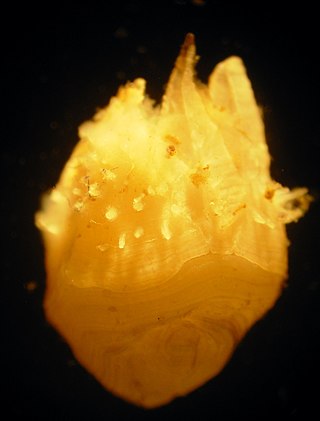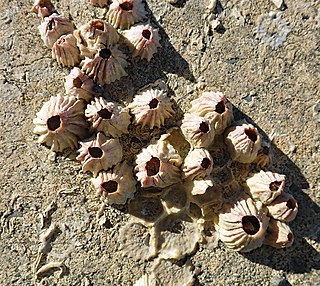
Barnacles are arthropods of the subclass Cirripedia in the subphylum Crustacea. They are related to crabs and lobsters, with similar nauplius larvae. Barnacles are exclusively marine invertebrates; many species live in shallow and tidal waters. Some 2,100 species have been described.

Chthamalus is a genus of barnacles that is found along almost all non-boreal coasts of the northern hemisphere, as well as many regions in the southern hemisphere. These small barnacles have been studied in part because of the taxonomic confusion over a group of species that, by and large, are morphologically and ecologically quite similar. In recent years, molecular techniques have identified a number of cryptic species that have been subsequently confirmed by taxonomists using morphological measurements. Most recently the genus has been shown to be paraphyletic, with the genus Microeuraphia nested within Chthamalus.

Chthamalus stellatus, common name Poli's stellate barnacle, is a species of acorn barnacle common on rocky shores in South West England, Ireland, and Southern Europe. It is named after Giuseppe Saverio Poli.

Acasta is a genus of barnacles in the family Balanidae, containing the following species:

Astreopora is a genus of stony corals in the Acroporidae family. Members of the genus are commonly known as star corals and there are seventeen species currently recognized.
Conopea is a genus of barnacle, containing the following species:

Pyrgomatidae is a family of barnacles belonging to the order Balanomorpha.

Perforatus is a genus of acorn barnacles in the family Balanidae. There is one described species in Perforatus, P. perforatus.

Notomegabalanus is a genus of acorn barnacles in the family Balanidae. There are about 12 described species in Notomegabalanus.

Notobalanus is a genus of acorn barnacles in the family Balanidae. There are at least two described species in Notobalanus.

Chirona is a genus of acorn barnacles in the family Balanidae. There are about six described species in Chirona.

Chionelasmus is a genus of symmetrical sessile barnacles in the family Chionelasmatidae. There are at least two described species in Chionelasmus.

Eochionelasmus is a genus of symmetrical sessile barnacles in the family Chionelasmatidae. There are at least two described species in Eochionelasmus.

Pachylasma is a genus of symmetrical sessile barnacles in the family Pachylasmatidae. There are about eight described species in Pachylasma.

Trevathana synthesysae is a species of coral barnacle in the family Pyrgomatidae.
Probathylepas is a genus of acorn barnacles in the family Probathylepadidae, the sole genus of the family. There is one described species in Probathylepas, P. faxian.
Parthenopea is a genus of parasitic barnacles in the family Parthenopeidae, the sole genus of the family. There are at least three described species in Parthenopea.
Pirusaccus is a genus of parasitic barnacles in the family Pirusaccidae, the sole genus of the family. There is one described species in Pirusaccus, P. socialis.

Triangulus is a genus of parasitic barnacles in the family Triangulidae, the sole genus of the family. There are at least four described species in Triangulus.

Waikalasma is a genus of symmetrical sessile barnacles in the family Waikalasmatidae, the sole genus of the family. There are at least three described species in Waikalasma.














